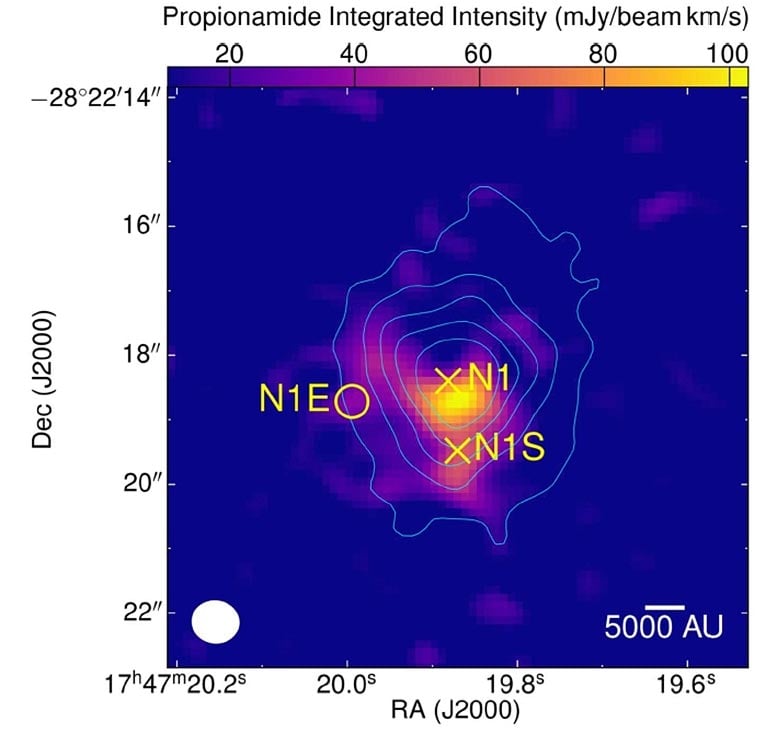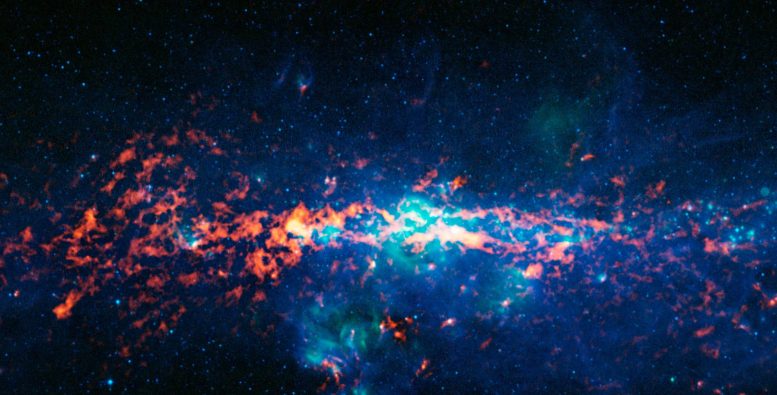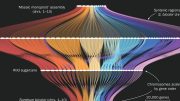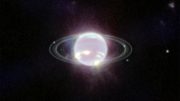
ALMA image of a part of Sgr B2. Distributions of 13CH3CN and propionamide are shown in contours and color scale, respectively. A compact cloud of warm gas, called hot core Sgr B2 (N1), is located At the center of the observing region.
Credit: Li et al. “Propionamide (C2H5CONH2): The Largest Peptide-like Molecule in Space,” The Astrophysical Journal, 919, 4. September 16, 2021. Copyright: AAS.
Proteins are polymers of amino acids joined together by the peptide bond -NHCO-. Peptide bonds are not only the ubiquity structures in proteins but also the characteristic structures for proteins. Molecules with peptide-like bonds are of particular interest to understand possible routes of protein formation in space. Among 240 molecules detected in space, only four molecules belong to peptide-like molecules.
Sagittarius B2 (Sgr B2), the massive star-forming region located close to the Galactic Center, is known as one of the best hunting grounds for complex organic molecules in the interstellar medium. Many prebiotic molecules have been detected in Sgr B2. Observations using the Shanghai Tianma 65m (213ft) telescope have revealed widespread complex organic molecules around Sgr B2. However, the abundant emissions caused serious line-blending in Sgr B2 and made identifying new molecules in Sgr B2 particularly difficult.

Color-composite image of the Galactic Center and Sagittarius B2 as seen by the ATLASGAL survey. The center of the Milky Way is home to a supermassive black hole more than four million times the mass of our Sun. It is about 25,000 light-years from Earth. Sagittarius B2 (Sgr B2) is one of the largest clouds of molecular gas in the Milky Way. This dense region lies close to the Galactic Center and is rich in many different interstellar molecules. In this image, the ATLASGAL submillimeter-wavelength data are shown in red, overlaid on a view of the region in infrared light, from the Midcourse Space Experiment (MSX) in green and blue. Sagittarius B2 is the bright orange-red region to the middle left of the image, which is centered on the Galactic Center. Credit: ESO/APEX & MSX/IPAC/NASA
Recently, an international group led by Juan Li from Shanghai Astronomical Observatory and Xing Lu from the National Astronomical Observatory of Japan, reported the detection of propionamide (C2H5CONH2) toward Sgr B2 for the first time with the Atacama Large Millimeter/submillimeter Array (ALMA). This is the largest peptide-like molecule detected in space.
Based on the high resolution and high sensitivity ALMA data, they find a possible propionamide transition whose intensity and velocity are consistent with simulations. The detection of propionamide in Sgr B2 demonstrates that interstellar chemistry can reach sufficient levels of complexity to form relatively large peptide molecules and shows the possible growth of larger amide molecules from smaller ones in a massive star-forming process.
Propionamide might also exist in massive star-forming regions in the Galactic disk, such as Orion KL. Future ALMA observations can reveal its presence.
Reference: “Propionamide (C2H5CONH2): The Largest Peptide-like Molecule in Space” by Juan Li, Junzhi Wang, Xing Lu (吕行)3, Vadim Ilyushin4,5, Roman A. Motiyenko6, Qian Gou (勾茜)7, Eugene A. Alekseev4,5, Donghui Quan (全冬晖)8,9, Laurent Margulès6, Feng Gao (高峰)10,11, Frank J. Lovas12,13, Yajun Wu (吴亚军)1,2, Edwin Bergin14, Shanghuo Li (李尚活)15, Zhiqiang Shen (沈志强)1,2, Fujun Du (杜福君)16,17, Meng Li (李梦)7, Siqi Zheng (郑思琪)1,2,18, and Xingwu Zheng, 16 September 2021, The Astrophysical Journal.
DOI: 10.3847/1538-4357/ac091c









Organic molecules near the center of The Milky Way sounds extremely interesting. What’ll be the next. Thank you for that article!
What the hell kind of headline is that?
Thanks for the note. There was a typo in the headline that has been fixed.